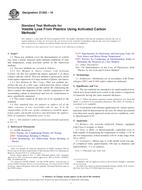We need your consent to use the individual data so that you can see information about your interests, among other things. Click "OK" to give your consent.
ASTM D1203-10
Standard Test Methods for Volatile Loss From Plastics Using Activated Carbon Methods
STANDARD published on 1.11.2010
The information about the standard:
Designation standards: ASTM D1203-10
Note: WITHDRAWN
Publication date standards: 1.11.2010
SKU: NS-16617
The number of pages: 3
Approximate weight : 9 g (0.02 lbs)
Country: American technical standard
Category: Technical standards ASTM
The category - similar standards:
Annotation of standard text ASTM D1203-10 :
Keywords:
plasticizer loss, vinyl, volatile loss, volatility, weight loss, Activated carbon methods, Methanol extract, Plasticizers, Plastics, Poly(vinyl chloride)(PVC) resins, Volatile loss, ICS Number Code 83.080.01 (Plastics in general)
Additional information
| Significance and Use | ||||||||||
|
The test methods are intended to be rapid empirical tests which have been found to be useful in the relative comparison of materials having the same nominal thickness. Note 2—When the plastic material contains plasticizer, loss from the plastic is assumed to be primarily plasticizer. The effect of moisture is considered to be negligible. Correlation with ultimate application for various plastic materials shall be determined by the user. To obtain accelerated tests that more nearly approach actual service conditions, refer to Specification . |
||||||||||
| 1. Scope | ||||||||||
|
1.1 These test methods cover the determination of volatile loss from a plastic material under defined conditions of time and temperature, using activated carbon as the immersion medium. 1.2 Two test methods are covered as follows: 1.2.1 Test Method A, Direct Contact with Activated Carbon—In this test method the plastic material is in direct contact with the carbon. This test method is particularly useful in the rapid comparison of a large number of plastic specimens. 1.2.2 Test Method B, Wire Cage—This test method prescribes the use of a wire cage, which prevents direct contact between the plastic material and the carbon. By eliminating the direct contact, the migration of the volatile components to the surrounding carbon is minimized and loss by volatilization is more specifically measured. 1.3 The values stated in SI units are to be regarded as the standard. 1.4 This standard does not purport to address all of the safety concerns, if any, associated with its use. It is the responsibility of the user of this standard to establish appropriate safety and health practices and determine the applicability of regulatory limitations prior to use. Note 1—This standard is similar in content (not technically equivalent) to ISO 176. |
||||||||||
| 2. Referenced Documents | ||||||||||
|
Similar standards:
Historical
1.12.2011
Historical
15.3.2007
Historical
15.3.2007
Historical
1.9.2006
Historical
1.3.2007
Historical
1.5.2014



 ASTM D4754-11
ASTM D4754-11 ASTM D5023-07
ASTM D5023-07 ASTM D5024-07
ASTM D5024-07 ASTM D5026-06
ASTM D5026-06 ASTM D5045-99(2007)e..
ASTM D5045-99(2007)e.. ASTM D5048-14
ASTM D5048-14 Cookies
Cookies
